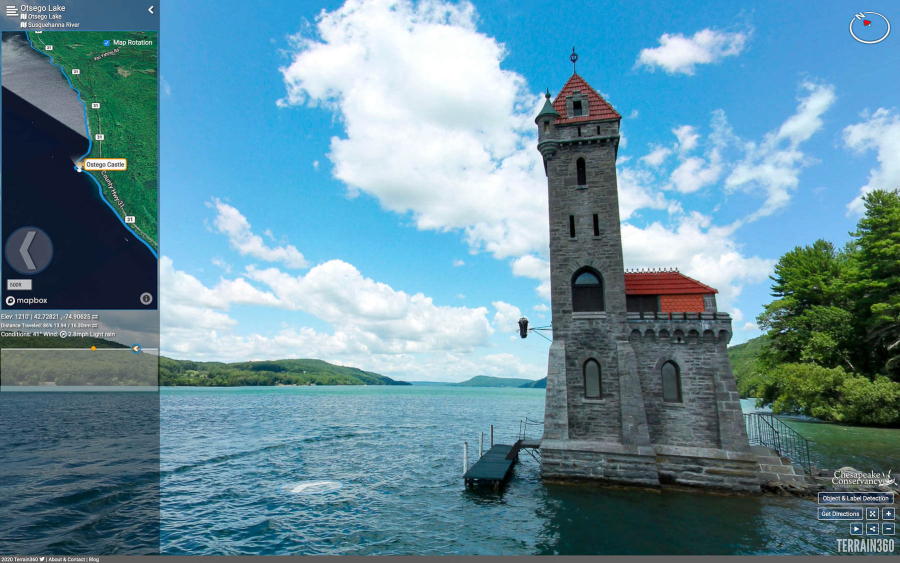Eight ways to explore the Chesapeake Bay from home

Spanning from Cooperstown, New York, to Norfolk, Virginia, the 64,000 square mile Chesapeake Bay watershed offers a wide range of recreational opportunities. While getting outdoors to explore the Chesapeake can be wonderful, sometimes you want to see what the watershed has to offer without having to travel. If getting outdoors is not an option, don’t fret! Here are eight ways to access the Bay from the comfort of your home.
1. Find Your Chesapeake at home
Find Your Chesapeake, the go-to site for trip ideas and places to visit throughout the watershed, also hosts a wealth of virtual activities. With critter cams, river trips and virtual tours of historical sites, Find Your Chesapeake offers an incredible range of options for those staying put.
2. Meet local wildlife with Chesapeake critter cams
Critter cams are a great way to get a glimpse into the daily lives of Chesapeake-region wildlife, from ospreys and bald eagles to black bear and American shad. Follow along as eggs are laid and hatched, parents feed their young or cubs scramble through the trees. You can even follow the drama of the Chesapeake Bay Foundation’s osprey cam, which focuses on a perch usurped by Canada geese. Will the osprey win it back? Check out our round-up of the region’s most popular critter cams for more.
3. Explore the Chesapeake Bay Program Field Guide
Explore our Field Guide to learn about some of the birds, fish, insects, invertebrates, mammals, plants, reptiles and amphibians that live in the Chesapeake Bay region. Find fun facts about the region’s most iconic species, like oysters and blue crabs, and even some of the Chesapeake’s lesser-known visitors, like sharks and flying squirrels. Be sure to check out our critter of the month and creature features to see the Field Guide’s new additions!
4. Get involved with community science
Your own backyard holds secrets just waiting to be discovered. Community science is an opportunity to provide valuable data to scientists while exploring the world around you. The Chesapeake Bay watershed offers a wide variety of community science opportunities, from listening for frogs to monitoring underwater grass beds. Learn more with 10 ways you can get involved in community science.
5. Take a virtual tour
No need for a road trip—there are a wide variety of places throughout the Chesapeake watershed you can visit virtually. Interested in maritime history? Take a virtual tour of one of Baltimore’s historic ships. Are your kids missing their field trips? American Dairy offers virtual farm tours for a variety of age groups. Yearning to be on the water? Check out one of these virtual river tours featuring Chesapeake Bay tributaries throughout the watershed.
6. Brush up on your Bay 101
Our Bay 101 video series features short, engaging videos to help you learn about the issues that affect the Bay and its restoration. You can learn how stormwater pollution affects our rivers and streams, why wetlands are vital to wildlife and water quality, how algae blooms form or what role blue crabs play in our ecosystem. Our overview of the Bay Program’s restoration efforts, Bay 101: Restoring the Chesapeake watershed, is a great place to start.
7. Try backyard birding
The Chesapeake Bay region is host to hundreds of species of birds throughout the year, and you can spot many of them in your backyard. So how does a rookie birdwatcher jump into backyard birding? Simply take some time to quietly observe. You can try to attract more birds to your yard with birdbaths or feeders. Use a field guide or app to help you identify the birds you see—the Merlin app from the Cornell Lab of Ornithology is a great one for beginners.
8. Start a garden
Planting native plants in your yard is an excellent way to increase wildlife habitat and help the Chesapeake Bay. Native plants provide the best source of food (seeds, berries and nectar) for bees, birds, butterflies and other wildlife—check out our guide to native plants for more. You can also grow your own food or start composting to reduce food waste. Get some tips for how to garden sustainably, and visit the Native Plant Center to design yours.
How are you staying connected to the Chesapeake from home? Let us know in the comments!

Comments
There are no comments.
Thank you!
Your comment has been received. Before it can be published, the comment will be reviewed by our team to ensure it adheres with our rules of engagement.
Back to recent stories